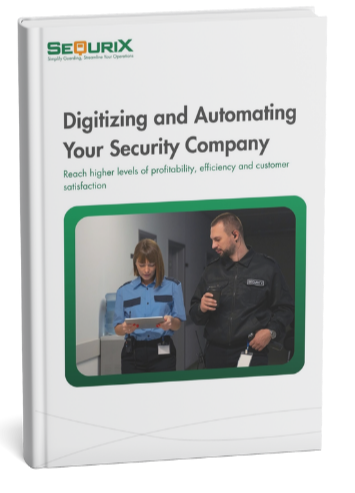Start digitizing your security company to increase operational efficiency, improve profitability and build lasting customer relationships
An effective and suitable mobile patrol app is crucial for optimally coordinating the work of security companies and ensuring the quality of the service to be provided. However, it is often difficult to choose a suitable provider. In the following blog post, you can find out what you should look out for when searching for a suitable software solution and which functions are important.
What is a mobile patrol software?
As a digital solution, a mobile patrol app replaces paper-based work. It offers a wide range of benefits, including the ability to plan and carry out patrols more efficiently and minimize the administrative burden. Employees can record designated checkpoints on site via NFC tag, QR code, GPS, barcode or manually. This allows security companies to ensure that their employees were actually on site. These systems also make reporting easier, as all relevant data is already digitized.
What should be considered when selecting a mobile patrol app?
The selection criteria for a suitable software solution can sometimes be very individual and depend on the requirements that the system should fulfill. You should consider the following functions and points when comparing mobile patrol apps:
1. User-friendly interface
The best software is useless if it is too difficult to use and only complicates things. That's why one of the most important requirements for a mobile patrol app is user-friendliness. You should therefore look for an intuitive user interface that is easy to use. In addition, training courses offered by the software provider are also a welcome help in getting to grips with the new system more quickly.
2. Type of software model
When it comes to software, the question quickly arises as to which model it is offered in: Cloud-based – also known as Software-as-a-Service (SaaS) – or on-premise, i.e. installed locally on site. Most software solutions are now offered as SaaS, as this model has many advantages, including cost efficiency, scalability and up-to-dateness. In addition, you do not need your own servers to host the software.
3. App use and offline function
In addition to the software model, another point that should be considered when comparing mobile patrol apps is the operating system on which the (associated) app runs: iOs or Android. Using iPhones can result in higher costs compared to Android devices, as these are generally significantly more expensive. Accordingly, the potential financial loss in the event of the loss or defect of an Apple device is also higher than with Android due to the more expensive acquisition costs.
Moreover, you should make sure that the app can also be used in the event of a poor mobile connection or complete network failure. Your employees should always be able to carry out their work on site.
4. Checkpoint scan
The heart of a mobile patrol app is the checkpoint scan. Generally, NFC tags are scanned with a smartphone. However, checkpoints can also be scanned using QR codes, barcodes, GPS or manually. The more types of checkpoints are offered, the more flexible you are.
5. Cost structure and hidden fees
At first glance, many software providers appear to be very inexpensive. However, a closer look reveals hidden costs, such as mandatory smartphone purchases or NFC tags. It is therefore important to pay close attention to the pricing model used.
6. Customizability and integration
Good software should be able to be seamlessly integrated into existing systems. This can be a connection to ERP systems for automatic invoicing, but can also include more. If a mobile patrol app can be used beyond the basic functions, for example for alarm interventions, integration with ARC should be possible.
7. Automated reports
Automated reporting saves time and minimizes the susceptibility to errors, as no data has to be transferred manually. It is also particularly useful if the software not only generates the reports itself, but can also send them directly to customers (with prior checking), for example by email or via a customer portal.
8. Tamper-proof
A tamper-proof software (e.g. no manipulation of time stamps) contributes significantly to quality assurance and transparency of the services provided. This way, your customers and you as a security company can be sure that employees cannot simply trick the system.
9. Test version
A major advantage when comparing mobile patrol apps is free trial or even freemium versions, which can be used for an unlimited period of time. This gives you the opportunity to get an insight into your favored solutions without actually investing any money. In addition, you can test the systems extensively in practice.
10. Comparison websites
Comparison portals are always a great way to compare products with one another. Such platforms also exist for software solutions. SequriX, for example, has a profile on Capterra. Here you can compare functions with each other, but also read reviews. Such insights help enormously when comparing mobile patrol apps, as you don't have to laboriously search for the features on the providers' respective websites.
Conclusion: How to compare mobile patrol apps
Comparing mobile patrol apps provides you with valuable insights into the available systems that can meet your security requirements. Particularly important are innovative functions such as the integration of NFC tags for the documentation of tours in real time. This enables security staff to work more efficiently and have all relevant data available at all times. User-friendliness, mobile availability (e.g. through an offline function) and, of course, costs also play a decisive role.
When selecting a suitable system, free trial versions also help to find out whether a software solution actually meets your requirements. With a targeted comparison of the various providers and a clear understanding of your needs, you are guaranteed to find the right solution for your company.

Subscribe

